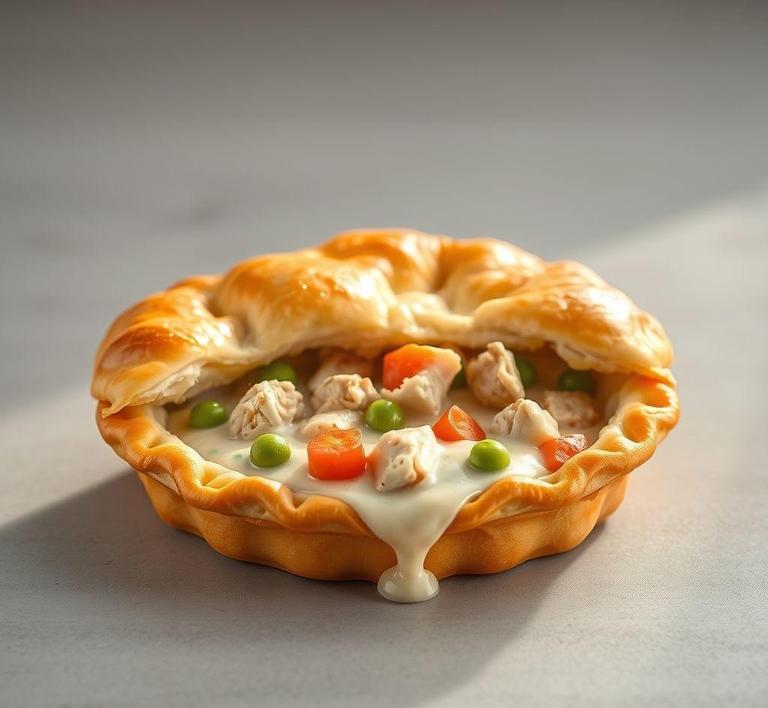If you’ve ever made a chicken pot pie and found yourself with leftovers, you might be wondering whether it’s safe to refreeze it. The good news is, you can refreeze chicken pot pie, but there are a few key things to keep in mind to ensure it stays tasty and safe to eat. From how to properly store it to the best techniques for reheating, this guide will walk you through all the steps to preserve that comfort food for later without compromising its flavor or texture. Whether you’re looking to extend the life of your homemade creation or store store-bought pies for a quick meal, we’ve got you covered!
Can You Refreeze Chicken Pot Pie?

Refreezing chicken pot pie is a question that often comes up when preparing meals in advance, storing leftovers, or dealing with partially thawed food. The simple answer is yes, you can refreeze chicken pot pie, but there are important considerations you should be aware of to maintain its quality, texture, and safety.
Chicken pot pie, a comforting and delicious dish made from tender chicken, creamy sauce, and a flaky crust, tends to be a little more complicated than other types of food when it comes to freezing and refreezing. While freezing is a great way to extend the life of leftovers or store meals for later, refreezing should be done carefully.
The key to successfully refreezing chicken pot pie lies in how it was thawed, how long it has been sitting out, and the overall quality of the pie before freezing. When food is thawed, bacteria can begin to grow if the food is left at room temperature for too long, and refreezing can increase the likelihood of freezer burn, texture changes, and loss of flavor.
In general, refreezing is safest and most effective if done quickly after thawing and if the pie was initially frozen properly. If it was only thawed in the refrigerator and not left out too long, it’s likely safe to refreeze. However, if it was left out for hours or thawed in warm conditions, refreezing is not recommended due to the increased risk of foodborne illness.
How To Refreeze Chicken Pot Pie?
Refreezing chicken pot pie requires careful steps to ensure both safety and quality. Here’s a step-by-step guide on how to do it properly:
-
Check the Pie’s Condition:
Before considering refreezing, examine the pie. Ensure that it hasn’t been left out at room temperature for over 2 hours (or 1 hour if the environment is particularly hot). If it has been, you should not attempt to refreeze it, as harmful bacteria may have developed.
-
Cool the Pie Quickly:
If you plan to refreeze your chicken pot pie, it’s important to cool it down as quickly as possible. Rapid cooling prevents bacteria growth and helps maintain the integrity of the pie when frozen again. You can do this by placing the pie in a shallow pan or cutting it into smaller portions, which will help it cool faster.
-
Wrap the Pie Properly:
Once the pie is cooled, wrap it tightly in plastic wrap or aluminum foil. Make sure the pie is fully covered with no gaps or exposed areas. To add an extra layer of protection, place the wrapped pie into a freezer-safe bag or airtight container to avoid freezer burn and preserve its quality.
-
Label and Date:
Always label your pie with the date it was refrozen. While chicken pot pie can last for months in the freezer, it’s a good practice to use it within 2-3 months for the best taste and texture. The longer it stays frozen, the more likely it is to lose its original texture and flavor.
-
Refreeze Immediately:
Place the wrapped pie into the freezer as soon as possible. Don’t let it sit out for more than a few minutes during this process. The faster it goes back into the freezer, the better the outcome will be when you thaw it again.
-
Thawing for Future Use:
When you’re ready to enjoy your refrozen chicken pot pie, it’s best to thaw it in the refrigerator for several hours or overnight before reheating. If you’re in a hurry, you can reheat it directly from frozen, but this might take a bit longer and may affect the texture.
Quality Impact
Refreezing chicken pot pie can have a noticeable impact on quality, and it’s important to understand what changes might occur.
-
Texture:
One of the most significant changes when refreezing a chicken pot pie is the potential alteration of its texture. The crust-which is meant to be flaky and crisp-can become soggy upon refreezing due to moisture that accumulates during the freezing and thawing process. The chicken and vegetables inside the pie may also become more rubbery and soft after going through the freezing cycle more than once. This is especially true if the pie wasn’t fully cooled before refreezing or if it was exposed to air in the freezer.
-
Flavor:
The flavor of chicken pot pie can degrade slightly after refreezing, especially if it has been stored in a non-airtight container or has been exposed to freezer burn. Freezer burn occurs when food is improperly wrapped, allowing air to come into contact with the food and causing it to dry out. This can result in a bland, less savory flavor, particularly in the creamy filling and the chicken.
-
Crust Integrity:
The crust is often the most vulnerable part of the chicken pot pie when it comes to refreezing. Freezing and thawing can cause the fat in the crust to become less effective, leading to a crust that might be more doughy or dense rather than light and flaky. The longer a pie stays frozen, the more the crust can suffer, especially if it’s exposed to moisture.
-
Moisture and Soupy Filling:
Refreezing a chicken pot pie can also lead to the filling becoming more watery or soupy once it’s thawed and reheated. This is because the ingredients inside the pie, such as chicken, vegetables, and sauce, contain water that separates and leaks out when frozen and thawed multiple times. Reheating at high temperatures can exacerbate this issue, leaving you with a less-than-ideal texture.
-
Safety Concerns:
The most significant concern when refreezing chicken pot pie is food safety. If the pie was not handled properly during the thawing process (left at room temperature for extended periods), bacteria such as Salmonella or Listeria could have begun to grow, leading to a foodborne illness risk when consumed. It’s crucial to make sure that the pie has been kept at safe temperatures (below 40°F / 4°C) during both the thawing and refreezing process.
While it’s possible to refreeze chicken pot pie, it’s not always the best choice for preserving its taste and texture. Refreezing can cause changes in the quality, such as a soggy crust, watery filling, and a loss of flavor. Proper handling and freezing techniques-including rapid cooling, airtight wrapping, and careful monitoring of thawing times-are essential to minimize these effects. If you’re looking to enjoy the pie at its freshest, it’s best to avoid refreezing whenever possible.
If you do choose to refreeze, ensure that the pie was properly thawed, handled, and wrapped, and be mindful of its shelf life in the freezer. Even though refrozen chicken pot pie may not be as delicious as freshly made or initially frozen pie, it can still be a convenient and acceptable meal when handled correctly. So, while refreezing is feasible, a little extra care goes a long way in maintaining the quality and safety of your dish.
Is It Safe To Refreeze Chicken Pot Pie?
Refreezing chicken pot pie is a topic that often raises concerns about food safety, quality, and taste. The answer to whether it’s safe to refreeze chicken pot pie hinges on several factors, such as how the pie was originally stored, how it was thawed, and how long it was kept at room temperature. In general, while it is technically safe to refreeze chicken pot pie, there are some important guidelines to ensure both safety and quality are maintained.
When you freeze chicken pot pie for the first time, the key is to ensure that it was fully cooked before freezing. This minimizes the risk of bacterial growth. The process of refreezing, however, can present more complications. Refreezing works by halting microbial activity, but it doesn’t always prevent the degradation of texture or flavor, which can be a big concern with a dish like chicken pot pie, which has a delicate balance of ingredients like creamy filling and a flaky crust.
The biggest safety concern lies in the thawing process. If the pot pie was left out at room temperature for too long or thawed improperly, harmful bacteria can start to multiply, making it unsafe to refreeze. The USDA recommends that food should not be left out at room temperature for more than two hours to prevent bacterial growth, and the more times food is frozen and thawed, the higher the risk of contamination.
If the chicken pot pie has been stored properly, both before and after thawing, and has not been at room temperature for extended periods, then refreezing is generally safe. However, it is crucial to ensure that the pie is reheated thoroughly (to 165°F or 74°C) when it is eventually consumed.
Signs That Chicken Pot Pie Should Not Be Refrozen
While the decision to refreeze chicken pot pie is often based on safety, it’s just as important to watch for signs that indicate a pie should not be refrozen. Several warning signs can indicate that refreezing could lead to foodborne illness or poor-quality results.
-
Improper Thawing
One of the most significant signs that your chicken pot pie should not be refrozen is improper thawing. If it was left out at room temperature for more than two hours or thawed in a way that allows parts of the pie to reach temperatures in the ‘danger zone’ (between 40°F and 140°F or 4°C and 60°C), it’s best to avoid refreezing. In such cases, the risk of bacterial growth is too high, making refreezing unsafe.
-
Changes in Texture or Appearance
If the chicken pot pie has a slimy or discolored filling, or if the crust is soggy and limp, these are signs that the pie may have been thawed too long or improperly stored. Refreezing could exacerbate these issues, leading to a poor eating experience and an increased risk of contamination. The creaminess of the filling may also separate, creating a watery texture that won’t reconstitute well after a second freeze.
-
Presence of Ice Crystals
Ice crystals that have formed inside the pie during storage or thawing indicate that moisture has been lost or redistributed, potentially impacting the taste and texture of the pie. While a small amount of ice crystals during freezing is normal, large patches of ice inside the filling or on the crust suggest that the pie has thawed and refrozen previously, which can degrade the overall quality.
-
Expired Storage Time
Chicken pot pie, like most dishes, has a shelf life when frozen. If the pie has been sitting in the freezer for more than three to four months, it may not be ideal for refreezing. While it might still be safe from a microbial perspective, the taste and texture may have already deteriorated, and refreezing could make it worse. Always label frozen foods with dates to avoid mishaps.
Common Refreezing Mistakes
Even if you’ve determined that your chicken pot pie is safe to refreeze, several common mistakes can compromise the process. Here are a few to watch out for:
-
Refreezing Without Proper Packaging
One of the most frequent mistakes people make when refreezing a chicken pot pie is not ensuring it’s well-sealed. If you refreeze it in a container that isn’t airtight, moisture can escape, leading to freezer burn. This not only impacts flavor but also the texture of both the filling and crust. Wrapping the pie tightly in plastic wrap followed by aluminum foil or using a vacuum-sealed bag is the best way to prevent this.
-
Refreezing After Partial Thawing
Thawing a chicken pot pie halfway and then refreezing it is a big no-no. If you refreeze part of the pie without fully reheating it to the correct temperature, you risk trapping bacteria that could grow and cause illness. Always make sure the pie is completely thawed before reheating to the proper temperature (165°F or 74°C), and never refreeze partially thawed food.
-
Not Considering the Impact on Quality
Even when it is safe to refreeze, many people overlook the fact that the quality of the chicken pot pie will degrade with each freeze-thaw cycle. The crust will likely become soggier, and the filling could lose its creaminess. If the pie is particularly delicate, refreezing may result in a mushy, unappetizing meal.
-
Not Labeling or Dating Freezer Items
One common oversight when refreezing chicken pot pie is failing to mark the date on the packaging. Without a date, it becomes difficult to keep track of how long the pie has been in the freezer. Not only does this make it harder to know if the pie is still safe to eat, but it also makes it difficult to monitor the quality of the food over time.
Tips And Tricks For Refreezing Chicken Pot Pie
To get the best results when refreezing chicken pot pie, follow these essential tips:
-
Cool the Pie Before Freezing
Always allow the chicken pot pie to cool to room temperature before placing it in the freezer. Hot food can raise the temperature inside the freezer, which may cause the pie to freeze unevenly and increase the risk of freezer burn. Let the pie cool for no more than two hours to ensure it remains within safe temperature ranges.
-
Use Portion-Sized Containers
Instead of refreezing an entire chicken pot pie, consider portioning it into individual servings. This way, you can reheat only what you need, reducing the chances of refreezing more than once. Small, airtight containers or freezer-safe bags work well for this purpose.
-
Double-Check the Storage Method
Make sure you wrap the pie tightly with plastic wrap, aluminum foil, or a vacuum-sealed bag. For extra protection, you can place the wrapped pie in a larger freezer bag or container. This prevents air from getting in, ensuring that moisture remains locked inside the pie.
-
Consider Freezing Before Baking
If you plan to make the chicken pot pie in advance, you can freeze it before baking. Assemble the pie, cover it tightly, and freeze it. When you’re ready to eat it, simply bake it straight from the freezer. This preserves the freshness and ensures you don’t have to worry about the quality degradation caused by refreezing after baking.
-
Refreeze Quickly
After thawing and reheating the chicken pot pie, if you decide not to eat all of it, make sure to refreeze it as soon as possible to avoid any bacteria growth. The longer the pie sits out after being reheated, the more risk it presents to food safety.
Conclusion
Refreezing chicken pot pie can be safe under the right circumstances, but there are important precautions to take to ensure that both food safety and quality are maintained. The most important considerations include proper thawing, good storage practices, and monitoring the pie for signs of spoilage. While refreezing does not necessarily mean that your chicken pot pie will be ruined, it does increase the likelihood of texture and flavor deterioration.
By following the tips mentioned, such as portioning the pie before freezing and ensuring it’s tightly wrapped to prevent freezer burn, you can reduce the chances of compromising the dish’s integrity. However, always pay attention to signs of spoilage-if the pie has been left out too long or shows signs of bacterial growth, it’s better to discard it than to risk your health.
In the end, if done correctly, refreezing chicken pot pie can be a great way to preserve leftovers, but it’s important to do so with caution. By considering both food safety and the potential impact on the dish’s texture and flavor, you can enjoy your chicken pot pie even after it’s been frozen, without sacrificing its quality.


